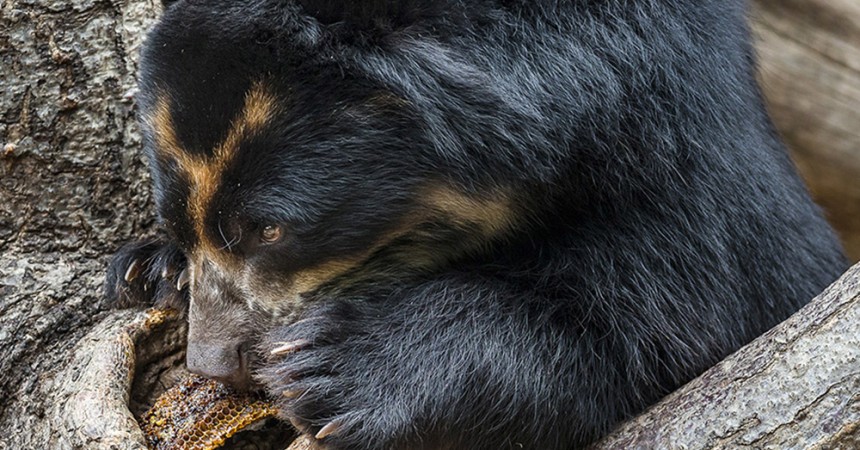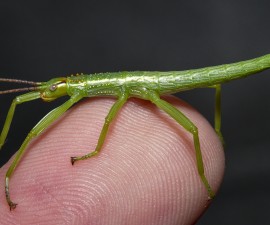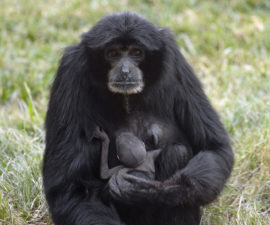
Turbo, an Andean bear, enjoys a special treat—honeycomb harvested from a hive discovered on the Zoo grounds.
Turbo, an Andean bear at the San Diego Zoo received a special treat this morning. The energetic and curious bear entered his habitat to find several pieces of honeycombs filled with delicious honey. Each piece was strategically placed around his enclosure, so Turbo had to do a little bit of work to get to them. Crowds watched as he climbed, crawled and pulled to get a taste of the sweet treats. After a few minutes of eating, he took a break to walk around and explore his enclosure. Animal care staff says he will continue to go back and eat the honey throughout the day.
“We strive to match our animals’ natural ability to an appropriate challenge,” said Jessica Sheftel, Animal Care Supervisor for Enrichment. “We don’t want it to be too easy or too frustrating, but sometimes it can take multiple days for an animal to problem solve a situation. If, however, it does prove to be a little difficult, we can take a step back and then begin to approximate and increase the challenge.”
The honey is used as an enrichment option, which is important for bears at the Zoo. The honey, as well as the process of getting to each honeycomb piece, keeps him stimulated and active, and allows him to show natural behaviors.
The honeycomb pieces were harvested from a 12-foot hive that was found inside a sound barrier on the edge of Zoo grounds. The Zoo’s Entomology team spent a whole day removing the extensive hive and preparing the bees for their new home with a local beekeeper. The process of removing the hive and safely relocating the bees is a part of San Diego Zoo’s commitment to conservation.
“Pollinators are in decline globally, and we are committed to their conservation here at the San Diego Zoo,” said Paige Howorth, animal care manager for invertebrates. “We have a pollinator garden to attract native bees and butterflies, and a monarch butterfly habitat to encourage monarch reproduction. Honey bees are important pollinators too, so whenever we encounter a swarm or colony in a questionable place on grounds, we do our best to relocate it.”
Andean bears come from the Andean countries of South America. They are commonly known as spectacled bears because of the rings of white or light fur around their eyes. Their populations are vulnerable to extinction, due to poaching and habitat loss. Those who want to help San Diego Zoo Global Wildlife Conservancy lead the fight against extinction can find out how by visiting endextinction.org.
Bringing species back from the brink of extinction is the goal of San Diego Zoo Global. As a leader in conservation, the work of San Diego Zoo Global includes on-site wildlife conservation efforts (representing both plants and animals) at the San Diego Zoo, San Diego Zoo Safari Park, and San Diego Zoo Institute for Conservation Research, as well as international field programs on six continents. The work of these entities is inspiring children through the San Diego Zoo Kids network, reaching out through the Internet and in children’s hospitals nationwide. The work of San Diego Zoo Global is made possible by the San Diego Zoo Global Wildlife Conservancy and is supported in part by the Foundation of San Diego Zoo Global.
Photo taken on September 10, 2015 by Ken Bohn, San Diego Zoo





